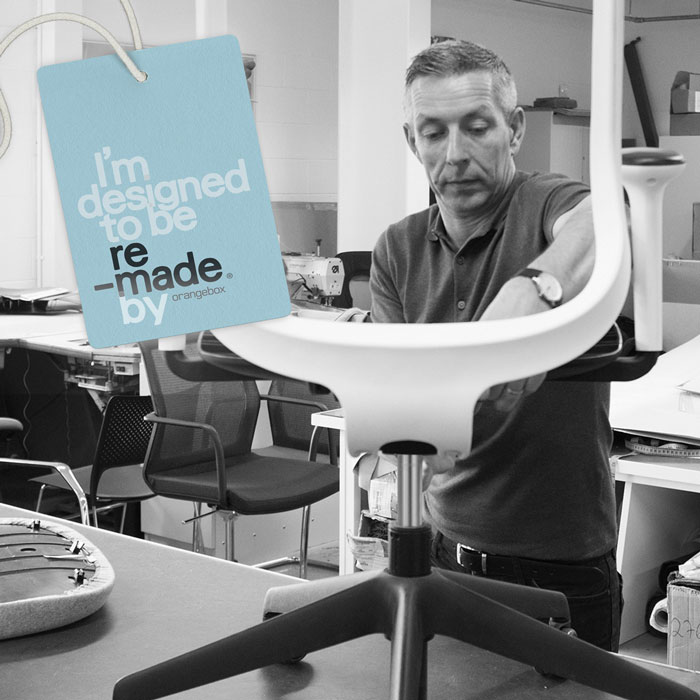Sustainable Innovation Interview Series: Gareth Banks, Orangebox
Understandably sustainability is an important topic of conversation between Commercial Interior Designers and Suppliers. This series of interviews aims to share knowledge of new materials but goes on to challenge how circularity can succeed in the commercial sector and what that production model may look like. We also focus on action by asking our interviewees to share examples of how they’ve delivered sustainably innovative projects in order for the sector as a whole to learn and grow.
We sat down with our Sustainability Ambassador Gareth Banks, Head of Sustainability at Orangebox, to have a clearer insight into his experience and expertise.
Enjoy the full Sustainable Innovation Interview Series here

Please could you introduce yourself and your role?
I’m an industrial designer by training and have been working for Orangebox for 20 years as part of our in-house design team. Just over a year ago I got the opportunity to become Head of Sustainability here at Orangebox, so I’m now focused on how we adapt and respond to the climate crisis with a role that covers our operational impacts as well as our continued commitment to sustainable design. I’m still working closely with the design team here but also have a remit to shape our business-wide decarbonisation plan over the coming decade & beyond. It’s extremely challenging at times but pretty much my dream role too which helps keep my optimism and energy-levels up where they need to be!
What innovation have you found in materials suitable for commercial interiors?
The work we’ve done so far using the Greenhouse Gas Protocol to map our emissions makes it very clear that for manufacturers like us, it’s the materials we use within our products that have the biggest impact on our carbon footprint overall. So material selection (low embodied carbon) & innovation plays a huge role in driving our design decisions. We’re now much more tuned into the carbon intensity (embodied emissions per kg) of the materials we’re using and looking to drive this down over time. Using natural materials wherever we can is a great way to do this of course but where we do have to use metals and polymers, we’re now looking for recycled grades as a first choice. Thankfully, the quality and consistency of what’s now available is better than ever. We’ve also started using an amazing material that’s made from reprocessed landfill waste that has some incredible GHG avoidance benefits, it’s innovations like these that are really helping reduce our carbon footprint.
Can circularity truly be integrated within a commercial interior project?
We’d probably all admit that we’re still only at the foothills right now, but it’s another area where there’s a lot happening quite quickly. More manufacturers are now taking back End of Life product and some are going further still. We’re launching a new service called re-made by Orangebox that aims to give fresh value and additional life to existing Orangebox furniture items that have come to the end of their current use. Our re-made furniture provides the same reliable performance, but with a greatly reduced carbon footprint when compared to new. This type of option is truly circular but it does mean that the end client and the project’s design team do have to think a bit differently in order to make it work.
How have you addressed innovation within the production, and end of life, of your products?
We think design is the key to a successful transition towards a truly circular economy. When we first started looking into this topic a few years ago, it was clear to us straight away that ideas like remanufacturing can only work properly if the product has been designed to facilitate reuse from the outset. So a lot of our innovation over the last 5 years especially has been focused in this area. We use a variety of eco-design strategies to help try and ensure this is the case, for example; design simplification, dematerialisation, material identifiers, design for dis-assembly, these useful tools we employ to keep our materials at their highest value for the longest time possible.
How could you work with Commercial Interiors Designers in order to deliver sustainable projects which achieve high levels of accreditation?
There’s obvious gains to be made from working more closely and sharing clearer information to ensure the best environmental outcomes. We’re certainly working on how we communicate the environmental attributes of individual products, so the information is more easily understood. For a product attribute like recycled content, this is quite straightforward of course. But putting a value on a criteria like “circularity” can be quite a challenge as there’s a high number of factors that could be taken into consideration, and some even conflict with each other. For example, aluminium is a great material when it comes to re-manufacturing but has a high carbon intensity per kg of material used. With so many “moving parts” to a project and so much choice from a crowded marketplace, clear and reliable communication from manufacturers around sustainability performance is likely to really help I think.
What is the next step in the sustainable conversation and who is it between?
If we’re serious (as an industry) about meaningful decarbonisation at the scale and speed that’s required, then for me, cracking the challenges around product re-manufacturing and re-use has to play a key role. We all have businesses to run successfully but we need to get better at creating value without using new resources every time. We’re big on the idea that this is a shared responsibility and as such, it should also be a shared conversation across all the links the chain. I’m still frustrated by the speed of change but I’m also really encouraged by the direction of travel. We’re seeing a growing number of corporate companies taking their environmental impacts way more seriously than I’ve ever seen before, and this market pull is really helping kickstart some action at last.




